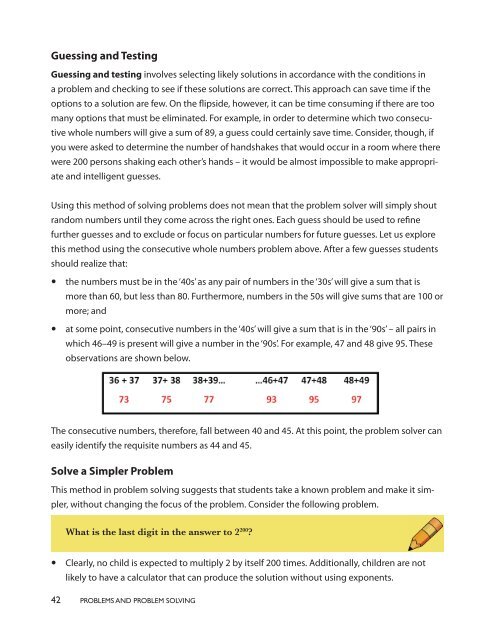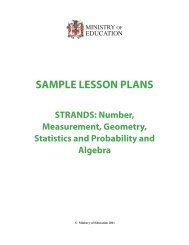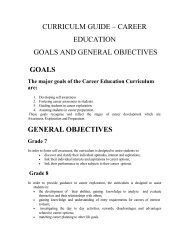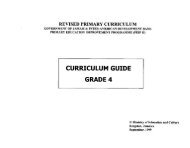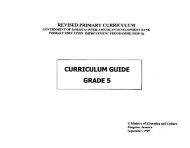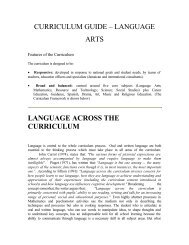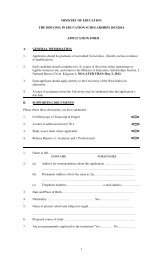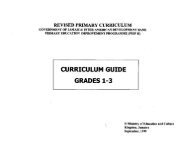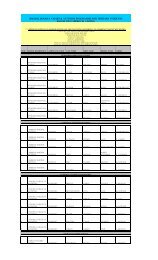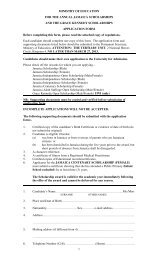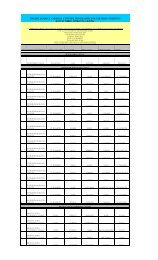Problems and Problem Solving - Ministry of Education
Problems and Problem Solving - Ministry of Education
Problems and Problem Solving - Ministry of Education
You also want an ePaper? Increase the reach of your titles
YUMPU automatically turns print PDFs into web optimized ePapers that Google loves.
Guessing <strong>and</strong> Testing<br />
Guessing <strong>and</strong> testing involves selecting likely solutions in accordance with the conditions in<br />
a problem <strong>and</strong> checking to see if these solutions are correct. This approach can save time if the<br />
options to a solution are few. On the flipside, however, it can be time consuming if there are too<br />
many options that must be eliminated. For example, in order to determine which two consecutive<br />
whole numbers will give a sum <strong>of</strong> 89, a guess could certainly save time. Consider, though, if<br />
you were asked to determine the number <strong>of</strong> h<strong>and</strong>shakes that would occur in a room where there<br />
were 200 persons shaking each other’s h<strong>and</strong>s – it would be almost impossible to make appropriate<br />
<strong>and</strong> intelligent guesses.<br />
Using this method <strong>of</strong> solving problems does not mean that the problem solver will simply shout<br />
r<strong>and</strong>om numbers until they come across the right ones. Each guess should be used to refine<br />
further guesses <strong>and</strong> to exclude or focus on particular numbers for future guesses. Let us explore<br />
this method using the consecutive whole numbers problem above. After a few guesses students<br />
should realize that:<br />
•y<br />
the numbers must be in the ‘40s’ as any pair <strong>of</strong> numbers in the ‘30s’ will give a sum that is<br />
more than 60, but less than 80. Furthermore, numbers in the 50s will give sums that are 100 or<br />
more; <strong>and</strong><br />
• at some point, consecutive numbers in the ‘40s’ will give a sum that is in the ‘90s’ – all pairs in<br />
which 46–49 is present will give a number in the ‘90s’. For example, 47 <strong>and</strong> 48 give 95. These<br />
observations are shown below.<br />
The consecutive numbers, therefore, fall between 40 <strong>and</strong> 45. At this point, the problem solver can<br />
easily identify the requisite numbers as 44 <strong>and</strong> 45.<br />
Solve a Simpler <strong>Problem</strong><br />
This method in problem solving suggests that students take a known problem <strong>and</strong> make it simpler,<br />
without changing the focus <strong>of</strong> the problem. Consider the following problem.<br />
What is the last digit in the answer to 2 200 ?<br />
•y<br />
Clearly, no child is expected to multiply 2 by itself 200 times. Additionally, children are not<br />
likely to have a calculator that can produce the solution without using exponents.<br />
42 PROBLEMS AND PROBLEM SOLVING<br />
<strong>Problem</strong><strong>Solving</strong>.indd 42<br />
8/24/12 6:55:55 PM


